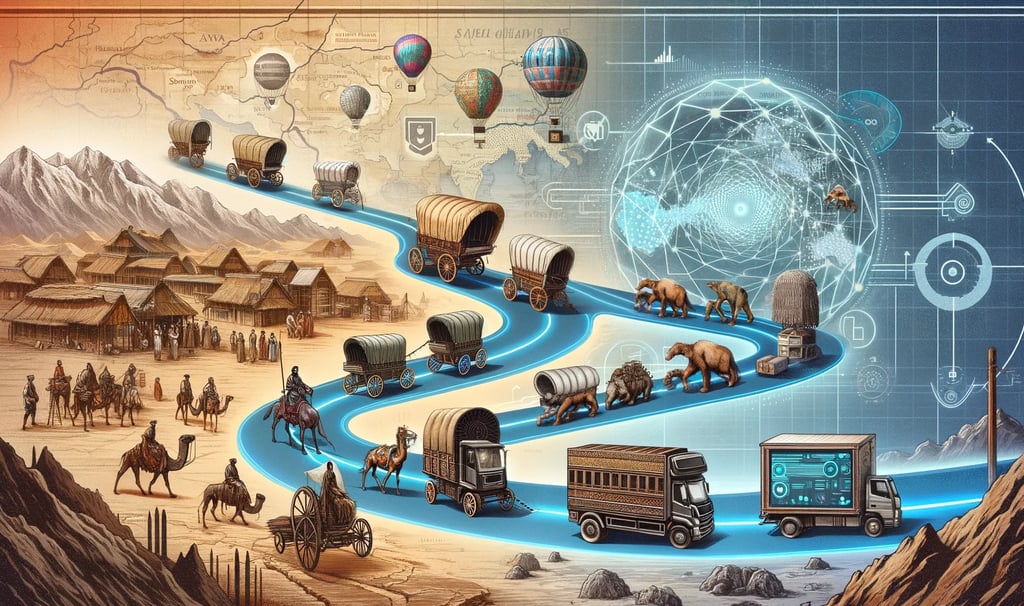Historical Evolution of Supply Chain Management
Explora la historia completa de la gestión de la cadena de suministro, desde la antigua Ruta de la Seda y la máquina de vapor hasta las redes globales impulsadas por IA de hoy.
SUPPLY CHAIN
The Procure 4 Marketing Team
11/23/20235 min read


Quick Answer: What is the History of Supply Chain Management?
The history of supply chain management is the story of human connection and innovation. It began with ancient trade routes like the Silk Road, which relied on caravans and manual coordination. The Industrial Revolution introduced the steam engine and railways, enabling mass production and faster distribution. Globalization in the 20th century created complex, international supply chains, which were then optimized by computerization and lean manufacturing principles like Just-in-Time (JIT). The Digital Age brought the internet and e-commerce, leading to the data-driven, automated, and AI-powered global networks we see today.
1. How Did Early Supply Chains Work? (The Silk Road Era)
Ancient supply chains were monumental feats of coordination and diplomacy. The most famous example, the Silk Road, was a network of trade routes stretching over 4,000 miles that connected China to Europe.
The Goods: Caravans transported high-value goods like silk, spices, coffee, and gold.
The Logistics: Trade was a trader-to-trader affair requiring meticulous planning. Merchants had to be experts in navigation, negotiation, and the customs of many lands.
The Hubs: Bustling rest stops called "caravanserais" acted as ancient logistics hubs where traders exchanged goods, currency, and information.
The Risks: These early supply chains faced risks similar to today, including bandits (piracy), natural disasters, and the spread of disease. Their resilience was a testament to early ingenuity.
The Impact: More than just a trade route, the Silk Road was a conduit for the exchange of culture, technology, and ideas, laying the groundwork for our interconnected world.
2. How Did the Industrial Revolution Change Supply Chains?
The invention of the steam engine in the 18th century marked a seismic shift. Production and logistics were no longer limited by human or animal power.
Centralized Production: Steam-powered factories enabled mass production of goods like textiles on an unprecedented scale. This required a more coordinated supply of raw materials (like cotton) and a way to distribute finished products to distant markets.
The Rise of Railroads: The steam locomotive revolutionized land transport. Railroads became the arteries of commerce, connecting factories to cities and ports, dramatically cutting transportation costs and time.
Global Reach: Steam-powered ships and trains meant supply chains could operate on a predictable schedule and global scale. Goods from Europe could reach America in weeks, not months.
Early SCM Practices: This era saw the birth of modern logistics planning and warehouse management to handle the new volume and speed of trade.
3. How Did Globalization Create International Supply Chains?
After World War II, a global effort to promote peace through trade began. This interconnectedness transformed supply chains from national to sprawling international networks.
Free Trade: The creation of organizations like the World Trade Organization (WTO) reduced tariffs and standardized regulations, making international trade easier.
Cross-Border Production: Companies began optimizing costs by sourcing materials and manufacturing components in different countries. A single car, for example, could contain parts from dozens of nations.
New Technologies: Innovations like containerization—standardizing shipping containers—drastically simplified and lowered the cost of moving goods across oceans.
New Challenges: This global interdependence also meant supply chains were now vulnerable to international politics, regional economic crises, and cultural misunderstandings.
4. What Was the Impact of Computers on Supply Chains?
The quiet revolution of computerization introduced a level of precision and analytical power that was previously unimaginable. Data became as valuable as the goods being shipped.
Digital Inventory: Barcodes and scanners replaced manual logbooks, allowing for the real-time, error-free tracking of products.
Enterprise Resource Planning (ERP): Companies like SAP and Oracle developed ERP software that integrated all facets of an operation—procurement, production, inventory, sales—into a single digital platform.
Improved Forecasting: For the first time, managers could analyze vast amounts of historical data to predict future demand trends and prevent shortages.
5. What is Lean & Just-in-Time (JIT) Supply Chain Management?
Born in the resource-scarce environment of post-war Japan, the Toyota Production System (or "lean manufacturing") focused on eliminating waste and maximizing efficiency.
The Lean Philosophy: The core principle is to create more value for customers with fewer resources. This involves practices like continuous improvement (kaizen).
Just-in-Time (JIT) Inventory: This was a radical shift from stockpiling materials. JIT aims to have raw materials arrive from suppliers exactly when they are needed for the production process.
The Impact: JIT dramatically reduces warehousing costs and waste. However, it requires a perfectly synchronized supply chain and is vulnerable to disruptions, as there is no backup inventory.
6. How Did the Internet and E-commerce Transform Supply Chains?
The rise of the internet in the 1990s and the subsequent e-commerce boom shifted power to the consumer, placing immense pressure on supply chains to deliver speed, variety, and convenience.
Direct-to-Consumer (D2C): Businesses like Amazon could now sell directly to customers, bypassing traditional retail.
Real-Time Data & Analytics: GPS and RFID technology allowed managers to track goods across the globe with pinpoint accuracy. Analytics became essential for predicting demand and optimizing operations.
"Last-Mile Delivery": The final step of getting a package to a customer's doorstep became a critical battleground. Companies like UPS and FedEx invested heavily in technology to optimize delivery routes and speed.
Omni-channel Retailing: The lines between online and physical shopping blurred, requiring a flexible and transparent supply chain that could handle in-store pickup, online returns, and other hybrid models.
7. What Defines the Modern Supply Chain? (AI, IoT & Blockchain)
Today's supply chain is an intelligent, interconnected, and data-driven ecosystem.
Artificial Intelligence (AI): AI is the proactive brain of the modern supply chain. Machine learning algorithms analyze data to forecast demand, predict disruptions, and optimize inventory in real time.
The Internet of Things (IoT): A network of sensors provides real-time visibility. IoT devices can monitor the temperature of a refrigerated container or track the precise location of a package on a delivery truck.
Blockchain: This technology provides a secure and transparent digital ledger. It can be used to trace a product's entire journey from farm to table, ensuring authenticity and building consumer trust.
Robotics and Automation: Automated warehouses use robots to pick, sort, and pack products with incredible speed and accuracy, while drones and autonomous vehicles are beginning to transform delivery.
Frequently Asked Questions (FAQ)
Q1: What was the single biggest invention for modern supply chains?
While the steam engine and computer were revolutionary, many experts argue that the simple shipping container was the single biggest invention. Standardizing containers in the mid-20th century (containerization) made loading and unloading ships incredibly efficient, drastically cutting costs and enabling the massive scale of today's global trade.
Q2: What is the "bullwhip effect" in a supply chain?
The bullwhip effect is a phenomenon where small fluctuations in demand at the retail level become amplified as they move up the supply chain to wholesalers, manufacturers, and suppliers. It can lead to major inefficiencies like excessive inventory or stockouts.
Q3: Why is sustainability becoming so important in supply chains?
Modern consumers and regulators are increasingly concerned with the ethical and environmental impact of products. A sustainable supply chain focuses on reducing its carbon footprint, ensuring ethical labor practices, and using resources responsibly. It's becoming crucial for brand reputation and long-term business success.

